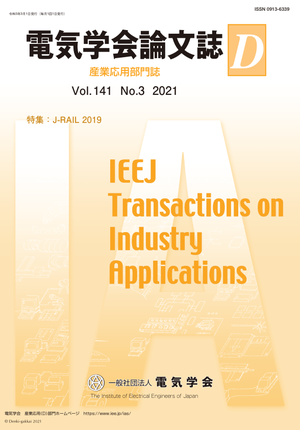次駅間の消費電力量と走行時分を評価関数に加えた通過時刻指定が可能な省エネ走行パタン作成手法の開発
次駅間の消費電力量と走行時分を評価関数に加えた通過時刻指定が可能な省エネ走行パタン作成手法の開発
カテゴリ: 論文誌(論文単位)
グループ名: 【D】産業応用部門
発行日: 2021/03/01
タイトル(英語): Development of a Generating Method for Energy Saving Running Profile Considering Energy Consumption and Running Time on Next Section
著者名: 堤 雄飛((株)日立製作所 研究開発グループ),小田 篤史((株)日立製作所 研究開発グループ),辻 雅樹((株)日立製作所 鉄道ビジネスユニット)
著者名(英語): Yuhi Tsutsumi (Research & Development Group, Hitachi, Ltd.), Atsushi Oda (Research & Development Group, Hitachi, Ltd.), Masaki Tsuji (Railway Systems Business Unit., Hitachi, Ltd.)
キーワード: 省エネ走行パタン,通過時刻指定,省エネ性能 energy saving running profile,applicability to passing time,energy saving performance
要約(英語): There is growing demand for energy saving to prevent global warming. Thus, the railway industry is focusing on energy saving. Power consumption by running trains has a large variation of about 20% caused by drivers' operation. Therefore, improving the running profile will considerably reduce energy consumption. Some algorithms for generating energy saving running profile have been researched and developed. To extend the applicability of energy saving running profile to various railway, we have developed an algorithm for generating energy saving running profile which fulfills target passing time on line which has passing stations between departure and arrival station like limited express train, in addition to between only adjacent stations like local line. Conventional algorithms do not optimize the passing speed because it generates running profile without consideration after the passing station. As a result, there is inefficient acceleration on the next section, and the energy saving performance is degraded. To solve this issue, we propose an evaluation function that adds energy consumption and running time on the next section when generating an energy saving running profile. The proposed method was evaluated by a running simulation, and the results show that the energy saving is improved by at most 4.7%, compared with the conventional method.
本誌: 電気学会論文誌D(産業応用部門誌) Vol.141 No.3 (2021) 特集:J-RAIL 2019
本誌掲載ページ: 276-282 p
原稿種別: 論文/日本語
電子版へのリンク: https://www.jstage.jst.go.jp/article/ieejias/141/3/141_276/_article/-char/ja/
受取状況を読み込めませんでした


